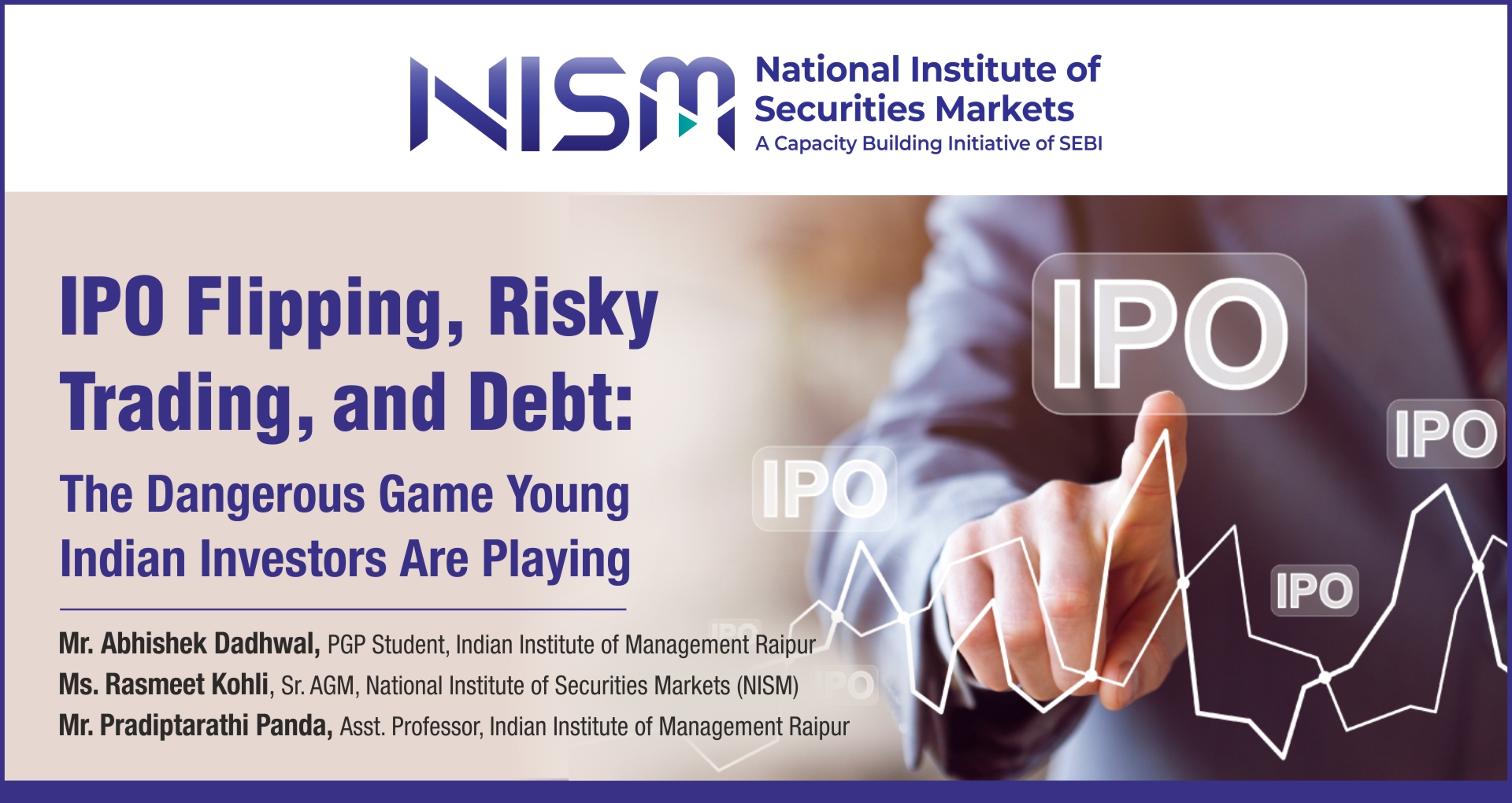
A new wave of retail trading is sweeping India’s markets, driven by the allure of quick wealth. Social-media “finfluencers” and familiar cognitive biases have spurred many young investors into speculative derivatives trading and IPO flipping. Encouraged by herd mentality, fear of missing out (FOMO) and overconfidence, inexperienced traders chase short-term gains instead of doing fundamental analysis.
Behavioral Drivers of Speculation
Investor psychology plays a key role. Young traders are prone to behavioral biases that amplify risk:
● Herd Mentality: Imitating the crowd. Many follow popular trades or tips from peers and influencers, rather than independent research. In markets, this can fuel asset bubbles and panic sell-offs as everyone chases the same idea.
● Fear of Missing Out (FOMO): Jumping into hype. The fear of missing a booming rally can prompt impulsive entries at overheated prices. Traders may buy simply because others are doing so, hoping to “ride the wave” before it’s too late.
● Disposition Effect: Selling winners too soon and hanging on to losers. Behavioral finance studies define the disposition effect as the tendency to cash out profitable positions quickly while avoiding realization of losses. Many young investors thus lock in small gains from an IPO listing, yet hold onto or even double down on stocks that have fallen, hoping to “break even.”
● Overconfidence: Overestimating skill or information. Novice traders often believe they can time the market or pick high returns based on limited research. This leads to excessive trading and underestimating the difficulty of speculation.
These biases feed directly into two popular strategies: leveraged derivatives trading and IPO flipping. Derivatives allow large bets with borrowed funds, magnifying gains and losses. IPO flipping refers to subscribing to a new issue solely to sell it quickly at the initial pop, instead of investing for the company’s fundamentals. Both practices expose the uninformed to huge downside if markets reverse.
Market Data and Trading Outcomes
Empirical market data confirm this speculative frenzy among youth:
● Intraday Trading Spike: Between 2022 and 2024, the count of intraday traders in India rose by about 5 times, with nearly 48% of new entrants under 30. Despite the hype, 93% of the 1.13 crore intraday traders during this period incurred net losses. In aggregate these traders lost ~Rs 1.8 lakh crore. (Put differently, the typical young trader making ~Rs 5 lakh annually burned through ~Rs 2 lakh on average.)
● Retail IPO Activity: The post-pandemic period saw a flood of first-time investors into IPOs. Nearly half of all demat accounts active in 2021–23 IPO subscriptions were opened after the COVID lockdowns. Meanwhile, demand from Non-Institutional Investors (NIIs) which typically experienced high-net-worth participants sharply declined, with NII oversubscription ratios falling from ~38 times to ~17 times. This suggests retail bidders (many young and unsophisticated) crowded the IPO market even as veterans pulled back.
● IPO Listing Returns: Analysis of IPOs listed Dec 2024 to Mar 2025 (80 issues total) reveals a speculative tilt. Of these, 57 IPOs opened with hefty gains (average listing jump of more than 40%), 9 opened roughly flat (0% gain), and 14 opened at a loss (average -12.5%). Half of the IPO shares allotted to retail investors were sold within one week, underscoring the “flip” mentality. In effect, many young subscribers captured initial listing profits and immediately exited, rather than holding for long-term value.
These figures paint a clear picture: young retail investors are overwhelmingly chasing immediate gains, often neglecting basic due diligence on company fundamentals. The short-term focus inflates listing prices and lures novices into chasing bubbles, only to suffer losses when momentum fades.
Financing Speculation through NBFC Loans
A critical question is how modest-income investors fund such aggressive trading. Industry reports suggest a key role for non-bank personal loans. The Fintech Association for Consumer Empowerment (FACE) found that in FY2023 to FY2024 NBFCs sanctioned nearly 14 crore personal loans, totaling about Rs 9 lakh crore. This explosive growth reflects the appeal of instant, often uncollateralized credit in the digital age.
Notably, these loans come at very high interest. Banks typically offer personal loans at around 11% per annum, whereas NBFC and fintech lenders charge up to 45%. The gap is stark and those with weak credit scores or urgent funding needs may be shut out by banks’ stringent criteria, so they turn to NBFCs’ fast, frictionless apps. In other words, subprime borrowers and desperate traders accept exorbitant rates in exchange for quick approvals.
This cycle of high-cost borrowing exacerbates losses. Young traders may borrow to cover losing trades or to leverage up for new bets. When trades go south, they re-borrow to recoup losses, perpetuating a debt spiral. RBI’s latest Financial Stability Report (Sep 2024) sounds the alarm: India’s bank NPAs are at a 12-year low (3.12% as of Sept 2024) thanks to a lending boom, but NBFCs remain vulnerable. The report highlights that NBFCs continue to have comparatively higher NPA levels due to their exposure to unsecured personal loans, and that unsecured lending by NBFCs is growing in double digits. In short, risk is accumulating on NBFC balance sheets. Many young traders could find themselves burdened by unmanageable debt as losses mount, threatening both household finances and NBFC stability.
Policy Imperatives and Institutional Responses
Addressing this multifaceted crisis requires coordinated action on several fronts:
1. Regulatory Strengthening of NBFC Lending: Regulators should tighten underwriting norms for personal loans, especially those lacking collateral or directed toward market speculation. For example, imposing risk-based credit assessment and end-use verification (requiring lenders to monitor whether a loan is used for trading) would help curb predatory NBFC practices. Enhanced supervision and higher provisioning for risky loan portfolios can protect lenders and borrowers alike. Similarly, measures like margin requirements or cooling-off periods for IPO subscriptions and derivatives to limit excessive leverage and speculative “flipping.”
2. Investor Education and Behavioural Finance Training: Long-term change hinges on smarter investors. Thus, India’s securities markets education body should play a pivotal role by developing modules on behavioural biases, risk management, and fundamental analysis. For instance, training programs could highlight common traps (FOMO, overconfidence, disposition effect) and reinforce the importance of scrutinizing business models and financials before investing. Equipping young traders with robust financial literacy will promote discipline. Embedding behavioural finance in certification courses and college curricula would help inoculate new investors against herd-driven mania.
3. Data-Driven Market Surveillance: RBI should leverage data analytics to detect early signs of speculative bubbles and risky credit flows. Real-time data-sharing between stock exchanges, brokerages and credit registries could flag anomalous trading patterns or a surge in margin / loan usage tied to market investments. Advanced algorithms and machine learning can monitor retail trading volumes, concentration of holdings, and velocity of IPO exits. Such surveillance would enable regulators to pre-empt systemic stress and adjust policies dynamically.
Conclusion
The convergence of social-media hype, behavioural biases and easy-but-costly credit has created a perilous environment for young investors in India. The evidence is unmistakable: a majority of inexperienced traders are losing hard-earned money on short-term bets, often funded by unsustainable loans. Beyond the personal toll on households, this trend poses broader financial stability risks (e.g. rising NBFC NPAs).
Institutional responses must therefore be two-pronged: tighten the credit and trading loopholes that fuel reckless speculation, and elevate the investment acumen of retail participants. Regulatory measures can curb obvious excesses, but ultimately sustainable markets depend on an informed investor base that prioritizes long-term value. By instilling prudent decision-making habits and emphasizing fundamentals over frenzy, we can help steer investors away from the dangerous cycle of quick gains and crushing losses and towards disciplined wealth creation.
Authors:
● Abhishek Dadhwal, PGP Student, Indian Institute of Management Raipur
● Rasmeet Kohli, Sr. AGM, National Institute of Securities Markets (NISM) .
● Pradiptarathi Panda, Asst. Professor, Indian Institute of Management Raipur
Disclaimer: The views expressed above are those of the authors alone and do not represent the views of NISM or affiliated institutions.
The piece had originally appeared in Live Mint.

Riding the stock market rollercoaster can be exciting, but it’s also exhausting. Bond investing on the other hand can build…

The Assets under Management (AuM) of passive equity funds, as of 31 st March, 2025, was about 27% of the…

Urban Infrastructure Financing in India: Challenges and Solutions for a Deeper Municipal Bond Market A World Bank report on ‘Financing…
© 2025 National Institute of Securities Markets (NISM). All rights reserved.